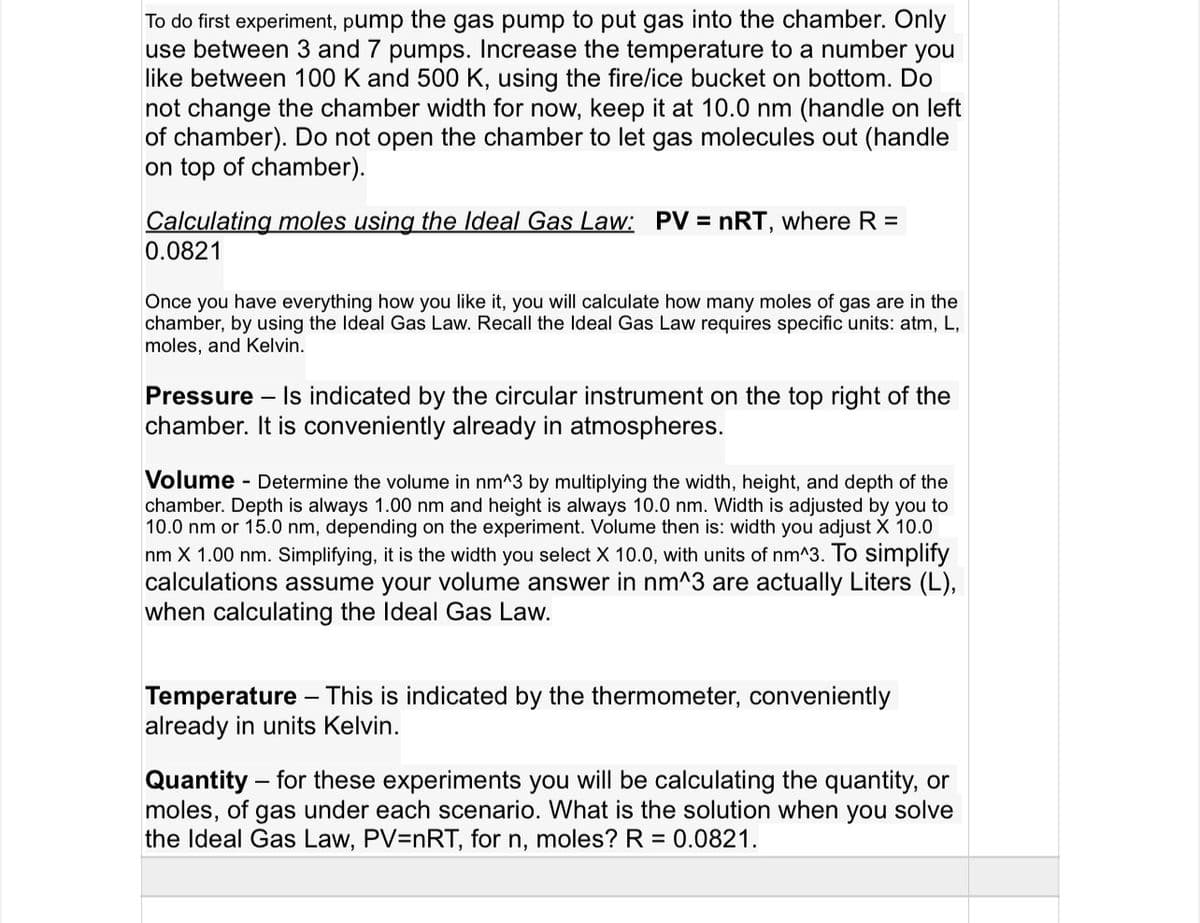Introductory Chemistry: An Active Learning Approach
6th Edition
ISBN:9781305079250
Author:Mark S. Cracolice, Ed Peters
Publisher:Mark S. Cracolice, Ed Peters
Chapter4: Introduction To Gases
Section: Chapter Questions
Problem 63E: A gas storage tank is designed to hold a fixed volume and amount of gas at 1.74 atm and 270C. To...
Related questions
Question

Transcribed Image Text:QUESTION 8
Is this second variable directly or inversely proportional to volume?
A. Inversely Proportional
B. Directly Proportional

Transcribed Image Text:To do first experiment, pump the gas pump to put gas into the chamber. Only
use between 3 and 7 pumps. Increase the temperature to a number you
like between 100 K and 500 K, using the fire/ice bucket on bottom. Do
not change the chamber width for now, keep it at 10.0 nm (handle on left
of chamber). Do not open the chamber to let gas molecules out (handle
on top of chamber).
Calculating moles using the Ideal Gas Law: PV = nRT, where R =
0.0821
Once you have everything how you like it, you will calculate how many moles of gas are in the
chamber, by using the Ideal Gas Law. Recall the Ideal Gas Law requires specific units: atm, L,
moles, and Kelvin.
Pressure
Is indicated by the circular instrument on the top right of the
chamber. It is conveniently already in atmospheres.
Volume
- Determine the volume in nm^3 by multiplying the width, height, and depth of the
chamber. Depth is always 1.00 nm and height is always 10.0 nm. Width is adjusted by you to
10.0 nm or 15.0 nm, depending on the experiment. Volume then is: width you adjust X 10.0
nm X 1.00 nm. Simplifying, it is the width you select X 10.0, with units of nm^3. To simplify
calculations assume your volume answer in nm^3 are actually Liters (L),
when calculating the Ideal Gas Law.
Temperature - This is indicated by the thermometer, conveniently
already in units Kelvin.
Quantity – for these experiments you will be calculating the quantity, or
moles, of gas under each scenario. What is the solution when you solve
the Ideal Gas Law, PV=nRT, for n, moles? R = 0.0821.
Expert Solution
This question has been solved!
Explore an expertly crafted, step-by-step solution for a thorough understanding of key concepts.
This is a popular solution!
Trending now
This is a popular solution!
Step by step
Solved in 3 steps with 1 images

Knowledge Booster
Learn more about
Need a deep-dive on the concept behind this application? Look no further. Learn more about this topic, chemistry and related others by exploring similar questions and additional content below.Recommended textbooks for you

Introductory Chemistry: An Active Learning Approa…
Chemistry
ISBN:
9781305079250
Author:
Mark S. Cracolice, Ed Peters
Publisher:
Cengage Learning

Living By Chemistry: First Edition Textbook
Chemistry
ISBN:
9781559539418
Author:
Angelica Stacy
Publisher:
MAC HIGHER

Introductory Chemistry: An Active Learning Approa…
Chemistry
ISBN:
9781305079250
Author:
Mark S. Cracolice, Ed Peters
Publisher:
Cengage Learning

Living By Chemistry: First Edition Textbook
Chemistry
ISBN:
9781559539418
Author:
Angelica Stacy
Publisher:
MAC HIGHER